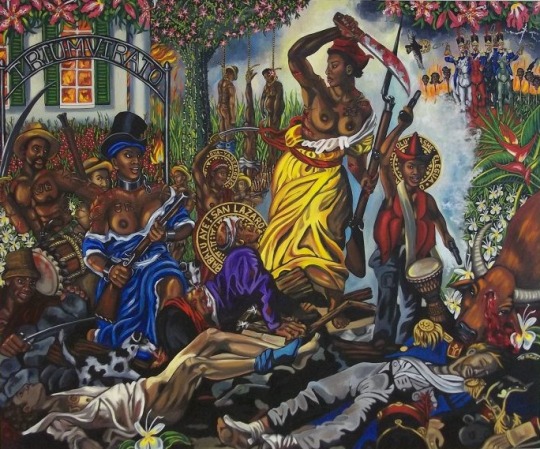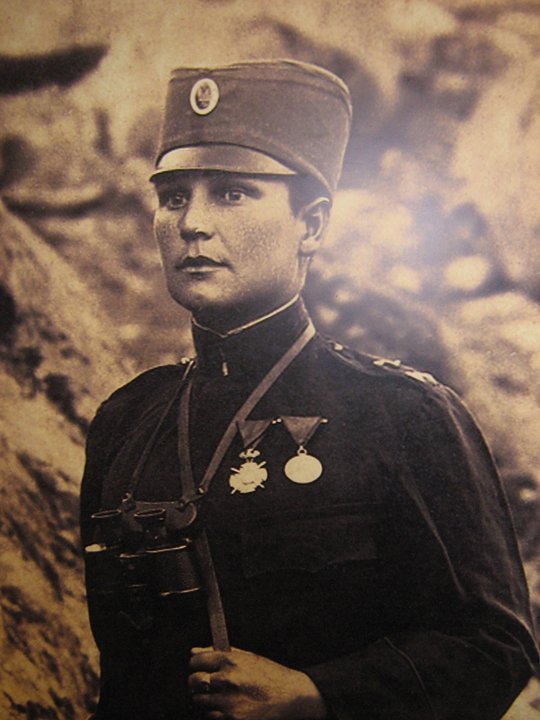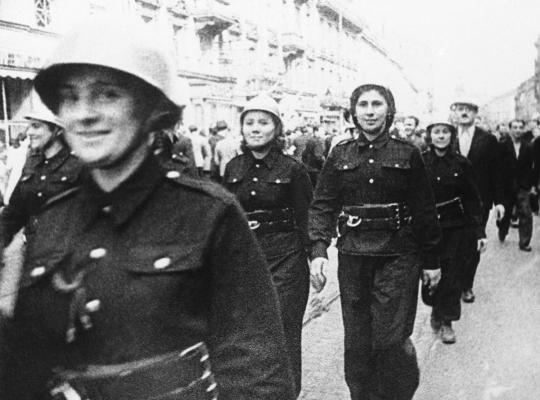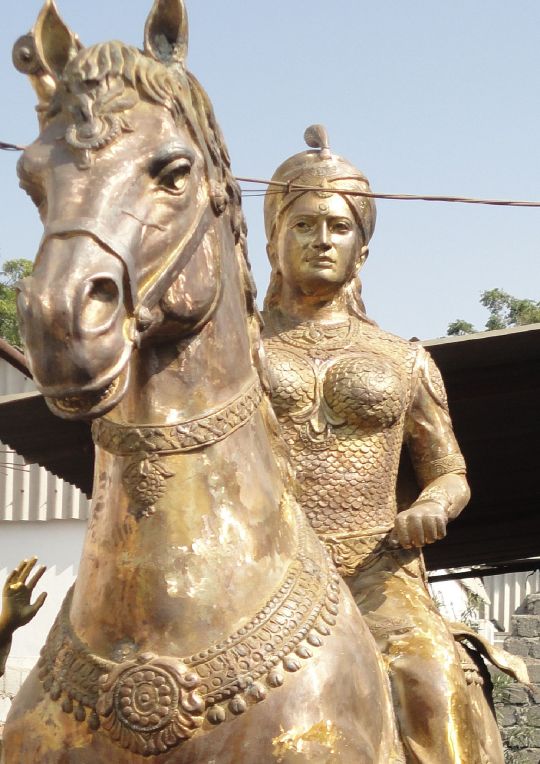Photo
I’m really pleased this post has reached a thousand notes. Keep boosting the signal folks!

Carlota was a Lucumí-Yoruba resistance fighter who led a slave rebellion in Cuba during the mid-19th century.
Kidnapped by slavers as child, Carlota was brought from West Africa to the Matanzas province of Cuba. There she worked as a slave harvesting sugar cane on the Triumvirato sugar plantation. In response to the appalling work conditions and brutal treatment by the Spanish landlords, Carlota began to plan an uprising along with another slave woman named Fermina. However Fermina’s role in the planning was discovered by the Spanish, who had her severely beaten and imprisoned.
Despite this Carlota continued to organise the uprising. Known for both her intelligence and musical skill, she sent coded messages using talking drums to coordinate a series of attacks. As the drums were a traditional instrument among the West African slaves, the Spanish were unaware that the music was also being used a form of communication. On November 3rd 1843, Carlota led a raid which freed Fermina and a dozen other slaves from captivity. On November 5th the uprising began by at the Triumvirato and Acane sugar plantations, forcibly overthrowing the Spanish owners. These attacks were led personally by Carlota, who went into battle wielding a machete.
The uprising continued for a year during which the rebels liberated slaves from at least five large sugar plantations in the Matanzas, as well as from a number of coffee and cattle estates. While many historians have focused on the physical strength of the slaves, their rebellion also showed great sophistication, using advanced guerrilla tactics and coded communication to achieve their goals. Eventually however the forces of the Spanish Governor were able to put down the rebellion due to their overwhelming numbers.
Carlota and Fermina were both captured and executed, and 1844 became known as the ‘Year of the Lashes’ due to the tide of violence inflicted upon the slave population to bring them back into line. However Carlota’s actions created a legacy which inspired numerous subsequent rebellions against white slave owners in the Caribbean. Today there is a monument to her at the Triumvirato sugar mill.
Image credit: Carlota Leading the Slaves in Matanzas by Lili Bernard. Sourced from Atlanta Blackstar.
2K notes
·
View notes
Photo

An Israeli soldier armed with an Uzi submachine gun during the 1967 Six Day War between Israel and neighbouring Egypt, Jordan, and Syria.
#Israeli soldier#female soldiers#women in war#history#women's history#Israeli history#Six Day War#uzi#submachine guns
227 notes
·
View notes
Text
Pingyang (598-623) was a rebel general and later princess who helped found the Tang Dynasty in China.
During the early 7th Century, China was ruled by Emperor Yang of the Sui Dynasty, who was extremely unpopular thanks to starting numerous wars and ordering construction projects to expand the Great Wall and Grand Canal which worked 6 million people to death. Pingyang’s father, Li Yuan, was one of Yang’s most successful generals. However in 617 the Emperor became paranoid about Li Yuan’s popularity and ordered for him to be executed. In response Li Yuan rose up in open rebellion against Yang’s rule.
At this time Pingyang was living in the capital, Chang’an, where her husband Cai Shao was head of the palace guard. With the news of Li Yuan’s rebellion the pair were forced to flee the city, separating to improve their chance of escape. Pingyang returned to her family estate to find the region was suffering from severe drought. She opened up the estate’s food stores to feed the local people and in doing so was able to recruit many of them to form her own army to fight against the Emperor, dubbed ‘The Army of the Lady’.
Selling everything her family owned to fund her rebellion, Pingyang added to her forces by assimilating the armies of local warlords, either through bribery or by defeating them on the battlefield and recruiting the surviving soldiers. She ultimately became commander of a force of over 70,000 rebels. She forbade her troops from looting, pillaging, or raping, instead insisting that after conquering an area that food should be distributed to the locals. Unsurprisingly this gained her immense popular support, increased even further by her repeated victories against the Emperor’s armies.
Joining up with the armies of her father and her husband, Pingyang’s forces captured the capital within a year. Yang fled the city and was later killed by his own men. Li Yuan became Emperor Gaozu of the newly founded Tang Dynasty, while Pingyang officially became a princess in addition to being awarded the rank of Marshall and the honorific title zhou, meaning 'wise'. However she only lived a few years in this role, dying aged only 23 of unknown causes. On her death, her father broke with tradition and insisted that Pingyang was given a military funeral in honour of her achievements.
#Pingyang#Princess Pingyang#female soldiers#female commanders#women in war#history#Chinese history#women's history#Emperor Yang#Emperor Gaozu#Sui Dynasty#Tang Dynasty#Chang’an
81 notes
·
View notes
Photo

Klavdiya Kalugina was one of the youngest Soviet snipers who fought during World War 2.
Born in 1926, Kalugina was aged 15 when Germany invaded the Soviet Union in 1941, at which time she was working in a munitions factory. Shortly after the invasion she joined the Komsomol (Communist Youth League) and in 1943 she was accepted into a Komsomol sniper school. Although she initially struggled with the training, Kalugina credited her graduation from the school to the patience of her squad commander.
Kalugina was sent to the front lines in March 1944 where she joined the 3rd Belorussian Front. Aged 17, she operated in a sniper/spotter team with a girl who she had trained with, Marusia Chikhvintseva. Her usual weapon was a Mosin-Nagant rifle with a PU scope, with which she engaged enemies at distances from as close as 200 metres to as far as 1200. She described her objective as eliminating key targets such as enemy commanders and machine gun emplacements, making one shot per day from a heavily camouflaged position and then returning to base at night.
Kalugina survived the war, although her partner, Chikhvintseva, did not. There is no account of her life following the end of the war.
An interview with Kalugina describing her experiences of her wartime experiences in detail can be read here.
#Klavdiya Kalugina#female soldiers#female snipers#women in war#history#women's history#Soviet history#soviet snipers#World War 2#Marusia Chikhvintseva
671 notes
·
View notes
Note
Hi love your blog but in your post about Flora Sandes you refer to her as British but she's Irish.
Hi there, glad you’re enjoying the blog!
Regarding Flora Sandes, you make a valid point so I have edited the post and also amended her entry on The Female Soldier website.
I think this came about because a lot of my sources referred to her as British because she spent her life in Britain and I repeated that without really thinking about it, but I agree that there is a distinction to be made. Thanks for the heads up.
5 notes
·
View notes
Photo

Mai Bhago, also known as Mata Bhag Kaur, was a Sikh woman who fought against the Mughal Empire in the early 18th century.
Mai Bhago was born in the village of Jhabal Kalan in the Punjab region of northern India, were in addition to being taught Sikh traditions she was trained by her father in horse riding and martial arts. She was a young woman during the period when oppression of Sikhs by the Mughal Empire was at its height. During 1704-05, the expansionist Mughal Emperor, Aurangzeb, invaded Sikh territory with an army of 16,000 troops and laid siege to the Sikh capital of Anandpur Sahib.
During the siege the Sikh leader, Guru Gobind Singh Ji, was abandoned by 40 of his elite warriors. Many of these men came from the region that Mai Bhago lived in and according to some accounts one of the deserters was her own husband. Outraged by this betrayal, Mai Bhago took her own horse, armour, and weapons and left home to track down the deserters. She went to their homes and persuaded their wives not to give their husbands shelter. Some of the women even armed themselves and joined Mai Bhago, pledging to fight for the Guru if their husbands would not. Shamed by this, the 40 deserters agreed to return to service with Mai Bhago.
During this time the Guru had escaped from the siege of Anandpur and was in retreat with his army. On 29th December 1705, Mai Bhago's small force helped to cover the Guru's retreat at the Battle of Muktsar. Knowing that the pursuing Mughals would need water she set up camp at the Khidrana reservoir, erecting numerous empty tents and clothes lines to make it appear as if a larger army was encamped there. When the Mughal army attacked the empty tents Mai Bhago's force ambushed them and in spite of being heavily outnumbered managed to push the Mughals back after intense fighting. Although victorious, Mai Bhago was the only Sikh survivor of the battle.
After the battle Mai Bhago joined up with the Guru's army and became his bodyguard. After the Guru's death in 1708 she retired to Jinvara, where she lived to an old age. Today she is remembered as a Sikh heroine whose actions served to ensure the survival of her faith.
#Mai Bhago#Mata Bhag Kaur#female soldiers#female commanders#women in war#history#women's history#Sikh history#Indian history#Battle of Muktsar#Aurangzeb#Gobind Singh Ji
1K notes
·
View notes
Photo

Susan Sonnheim is an American veteran formerly of the Wisconsin National Guard who served in the Iraq War. While on duty Sonnheim was the victim of a roadside bomb in Baghdad which left her body filled with shrapnel, blinding her in one eye as well as causing injuries to her spine and limbs. She only survived the attack because the bullet that penetrated her Kevlar vest and would have killed her was stopped by a tobacco tin in her pocket. Following her injuries, Sonnheim became the first woman in the National Guard to receive the Purple Heart medal awarded to wounded soldiers.
Since returning home to the US, Sonnheim has described a lack of acceptance of her veteran status because she is a woman and says there is gender bias in the care that American soldiers returning from war receive. She is quoted in The Guardian saying "There is no reason for women not to be in combat. It's a buddy system – you look after the person next to you whether they are male or female. Once you are a soldier, that's the way it is, a soldier is a soldier."
Photo credit: Tom Sperduto, sourced from TIME magazine.
#Susan Sonnheim#female soldiers#female veterans#American veterans#women in war#women's history#US history#Iraq War#National Guard#Purple Heart
137 notes
·
View notes
Photo

Queen Nzinga Mbande (1583-1663), sometimes referred to as Anna Nzinga, was ruler of the Ndongo and Matamba Kingdoms of the Mbundu people in what is now Angola.
As the favoured daughter of King Kiluanji of the Ndongo, Nzinga Mbande was brought up witnessing her father's governance of the kingdom first-hand. He even took her with him when he went to war. Kiluanji made deals with the Portuguese who were expanding their slave trading operations in South West Africa, and this relationship was maintained when her brother Ngola Hari became king. However in 1617 the Portuguese Governor Correia de Sousa launched attacks against the Ndongo kingdom that captured thousands of Mbundu people.
In 1621 when the Portuguese invited the Ndongo king to take part in peace talks, he sent his sister Nzinga Mbande in his place. At her famous first meeting with De Sousa chairs were only provided for the Portuguese, and Mbande was expected to sit on the floor. Instead she commanded one of her servants to go down on all fours and act as her chair. During the negotiations Mbande walked a fine line between preventing the Portuguese from controlling the kingdom as they had done in Kongo, while keeping options open to trade for firearms to strengthen her armies. In this she was successful, although as a condition of the agreement she had to convert to Christianity and was baptised as Anna de Sousa, with the Governor becoming her Godfather.
In 1626 Mbande became Queen of the Ndongo following the death of her brother. Her reign began in peril as the Portuguese went back on their deal with her and declared war, as did other neighbouring tribes. Forced into retreat from her own lands, Mbande led her people south to the kingdom of Matamba, which she attacked, capturing Matamba's Queen and routing her army. Mbande then installed herself as the new ruler of Matamba, from where she launched a prolonged campaign of guerrilla warfare against the Portuguese which would last for the next 30 years.
Mbande developed a legendary reputation as a warrior, although claims that that she took part in human sacrifice are likely the result of European propaganda and gossip. Accounts that she maintained a personal harem of more than 50 men are also unproven. What is known is that Mbande assembling a diverse army to oppose the Portuguese that included runaway slaves, defecting soldiers, and women. Exploiting European rivalries she made an alliance with the Dutch, which included acquiring her own personal bodyguard of 60 Dutch elite soldiers armed with rifles. Working with the Dutch, Mbande successfully defeated Portuguese armies in 1644, 1646, and 1647. However the Dutch were eventually pushed out of the region in 1648 and Mbanda was forced to carry on the fight alone. While she was never able to completely defeat them, she successfully resisted Portuguese invasion for decades.
Mbande continued personally leading her troops into battle until she was in her sixties, but the long war eventually wore both sides down. In 1657 she finally signed a peace treaty with Portugal. She then spent the rest of her life focused on rebuilding a nation which had been devastated by conflict and over-farming. She died of natural causes in 1663, aged 81. Today Nzinga Mbande is a symbol of Angolan independence, memorialised by numerous statues.
#Nzinga Mbande#Anna de Sousa#female soldiers#female rulers#African Queens#women's history#black history#history#women in war#colonialism#Angolan history#Portuguese history#Kiluanji#Ngola Hari#Correia de Sousa#Angola#Ndongo#Matamba#Mbundu
774 notes
·
View notes
Note
I just wanted to say how much I enjoy your profile picture; she is one of my heroes! :D
Thank you. Roza Shanina’s one of my heroes too and the first soldier I wrote about. :)
8 notes
·
View notes
Photo

It’s Women’s History Month and the Female Soldier website is adopting a new Featured Soldier! Milunka Savić was the most decorated woman in the history of war. In addition to her native Serbia, this heroine received medals from France, Russia, and Britain for her bravery in World War I.
#female soldiers#featured soldier#women's history#women's history month#history#women in war#female history#World War 1
136 notes
·
View notes
Photo

Polish women march through the streets of Warsaw as part of the city's defense forces during the German Invasion of Poland, 16th September 1939.
Photo from The Atlantic.
#female soldiers#women in war#history#women's history#Polish history#World War 2#Invasion of Poland#Warsaw
470 notes
·
View notes
Photo

Rudrama Devi (1245-1289) was a Warrior Queen of the Kakatiya dynasty in the Deccan Plateau of Southern India.
Rudrama Devi rose to power in 1259 during her early teens when she was appointed co-regent to jointly rule alongside her father, King Ganapati. While Ganapati had no sons, he gave her the male name of Rudra Deva and formally declared her to be his male heir, an image which she did nothing to deter as she dressed in male clothes. She married Veerabadra, a prince of Nidadavolu, with whom she had two female children, but he suffered an early death.
The first few years of Rudrama's conjoined rule with her father were marred by a Pandya invasion led by Jatavarman Sundara Pandyan I. While the invasion was eventually repelled, the Kakatiyas suffered a number of significant defeats and the kingdom was left in a weakened state. As a result of these failings her father withdrew from public life while passing control to Rudrama, and on his death in 1269 she was officially crowned as Rani (Queen). A number of noblemen, possibly including her own step-brothers, refused to submit to a woman's authority and rose up in rebellion against her. However Rudrama rallied an army with those nobles and chiefs still loyal to her and successfully crushed the rebellion.
Having secured her kingdom Rudrama spent the rest of her rule defending it from external threats. The Kakatiya were one of four major powers in Southern India who were frequently at war with each other. The Yadava king Maha Deva launched a sustained invasion on the Kakatiya from 1268 to 1270, culminating in a siege of the Kakatiya capital of Orugallu (now Warangal). After 15 days of fighting, an attack led by Rudrama routed the Yadavas and she pursued them in a long retreat back to their own territory during which many Yadavas were captured. Soundly defeated, Maha Deva was forced to pay an enormous ransom for the release of his soldiers. A later invasion by the Odias was also defeated by Rudrama's generals.
While adept at warfare, Rudrama was also known to have been an effective administrator and when Orugallu was visited by Marco Polo he described her as a lady of discretion who ruled with justice and equity. She also completed work on the Orugallu Fort, adding a second wall and a moat to the structure, which protected the city against numerous future sieges.
In 1280 Rudrama passed the mantle of leadership on to her grandson, Prataprudra, as she was growing old and had no male children of her own. However in 1285 a new threat arose in the form of the Kayastha Chief, Amba Deva, who had allied with the Pandyas and Yadavas to destroy the Kakatiya empire. Though elderly, Rudrama led an army to meet this three-pronged attack head-on, but was killed in the ensuing battle. The Katakiya empire would crumble over the following years, however Rudrama Devi's legacy is still well remembered in Southern India.
#Rudrama Devi#Rudramadevi#female soldiers#female rulers#warrior queen#women in war#history#women's history#Indian history#Ganapati#Maha Deva#Amba Deva#Orugallu#Warangal#Warangal Fort
418 notes
·
View notes
Photo

Gráinne Ní Mháille (c.1530 - c.1603), commonly known as Grace O'Malley, was a legendary Irish pirate and Chieftan of the Ó Mháille clan during the 16th century.
Born around 1530, Ní Mháille was the child of a wealthy sea trader who she accompanied on his voyages from a young age. As a teenager she was married to Donal Ó Flaithbheartaigh, heir to a powerful clan, as a political move. The marriage lasted for 19 years, during which they had three children and Ní Mháille gained considerable experience commanding ships in her husband's fleet.
Following the death of her husband and her father, Ní Mháille inherited a considerable amount of money and took over her father's fleet of 20 ships and hundreds of sailors. She built on her father's success to become one the dominant forces on the Irish west coast, launching raids on rival clans, forcing merchant ships to pay for safe passage, and imposing taxes on fishermen as far away as England. She also transported Gallowglass mercenaries between Scotland and Ireland, often raiding Scottish islands at the same time. Her position was strengthened by the control of several coastal castles, most prominent of which was Rockfleet Castle, which she gained through her second marriage to Risdeárd Bourke. After a year of marriage she is said to have taken control of the castle, barring Bourke from entering and yelling from a window, "I dismiss you!".
Ní Mháille had a tumultuous relationship with the English. From the early 1560's onward she was accused of piracy multiple times, but she won some favour with the English by assisting in coastal attacks on southern Ireland and won the respect of Sir Henry Sidney, the Lord Deputy of Ireland. However n 1579 she was besieged in her castle by English forces, who she defeated by pouring hot oil on the attackers and according to some accounts by making homemade bullets from melted down armour.
Ní Mháille made a lasting enemy in the form of Richard Bingham, the English ruler of Connacht, after she fought alongside the Bourkes in open rebellion against him from 1585 to 1589. Bingham sought revenge for the rebellion by targeting Ní Mháille, destroying her lands and property. Bingham killed Ní Mháille's eldest son, Eoghan, and captured his castle, while making a deal with one of her other sons, Murchadh, to switch sides. Ní Mháille swore never to speak to Murchadh again after his betrayal and burned his lands.
Financially ruined, the final blow to Ní Mháille came in 1593 when Bingham captured her other son, Tiobóid, as well as her brother and threatened them with charges of treason. Ní Mháille petitioned Queen Elizabeth of England directly to ask for their release. Elizabeth sent Ní Mháille a list of questions which she answered, and later that year the two women met at Greenwich Palace near London. Despite Ní Mháille's rough manners and refusal to bow, the two women, both in their sixties, seemed to develop a healthy respect for each other. As neither spoke the other's language they conversed in Latin, striking an agreement that Ní Mháille's family would be released, reparations would be made for her stolen property, and that Bingham would be removed from power.
The agreement did not last. Reparations were not fully made, and while initially stripped of his position, Bingham was eventually allowed to return to power in Ireland. Angered, Ní Mháille returned to helping Irish rebels during the Nine Years' War. She died of old age in Rockfleet Castle at the end of the war in 1603. After her death Ní Mháille's fighting prowess led to many Irish folk tales being told about her and she is still remembered as a legendary pirate.
#Gráinne Ní Mháille#Grace O'Malley#female pirates#pirate queen#women in war#history#women's history#Irish history#Bourke Rebellion#Nine Years War#Donal O'Flaherty#Richard Bourke#Henry Sidney#Richard Bingham#Elizabeth I#Connacht#Ireland#Greenwich Palace
3K notes
·
View notes
Photo

A soldier in Mushake, Congo, carries her child on her back.
Photo by Alissa Everett.
222 notes
·
View notes
Photo

Artist's depiction of a Sarmatian warrior
Amage was a Sarmatian warrior queen who lived toward the end of the 2nd Century BCE.
Amage was queen of the Sarmatians, an Iranian people who lived in the western region ofScythia on the coast of the Black Sea. According to the Greek strategist Polyaenus, while Amage's husband, Medosaccus, was officially the Samartian king, Amage deemed him to be an unworthy ruler who abused his power for personal luxury. She took control of the Sarmatian government and military, using her power to build defensive garrisons which she used to defend her lands on multiple occasions.
Her success as a leader made her famous throughout Scythia and led to the neighbouring Chersonesians to ask for her help when they were being threatened by the Crimean Scythians. Amage agreed to the alliance, sending a message to the Scythian king demanding that he leave the Chersonesians in peace. When the king refused she gathered a force of 120 seasoned warriors, equipping them with 3 horses each so they could cover ground quicky. Marching toward the Scythian palace they covered a distance of more than a 100 stades (180 kilometres) in a single night and a day. The swiftness of the attack caught the Scythian forces off guard and they were easily defeated. Personally leading the assault on the palace, Amage broke into the Scythian king's quarters and killed him along with his entire family save for one of his sons. She installed the boy as the new Scythian ruler, on the condition that Chersonesus would remain free and that the Scythians would never again attack their neighbours.
While little else is recorded of Amage's rule, Sarmatian women became known for having a prominent role in war and are recorded by Herodotus as fighting in the same clothing as men. Some believe that the exploits of Amage and similar Sarmatian women served as the inspiration for the Greek myth of the Amazons.
#Amage#female soldiers#female rulers#warrior queen#women in war#history#ancient history#women's history#Sarmatians#Scythians#Chersonesians#Polyaenus#Medosaccus#Herodotus#Amazons#Scythia#women warriors
552 notes
·
View notes
Text
Constance Markievicz
Born on February 4, 1868 in Westminster Countess Markievicz was an Irish Sinn Féin and Fianna Fáil politician, prominent figure in the Irish Revolution, suffragette, revolutionary nationalist and socialist.
21 notes
·
View notes
Photo

Minnie Spotted Wolf (1923–1988) was the first Native American woman to serve in the United States Marine Corps.
A member of the Blackfoot tribe, Spotted Wolf spent her childhood working on her father's ranch in Heart Butte, Montana, where she cut fence posts, drove trucks and broke horses. She first expressed an interest in joining the army when she was aged 18, shortly after the US entered into World War 2 at the end of 1941. However she was initially discouraged by a recruitment officer who told her that the war was 'not for women'.
Spotted Wolf was eventually accepted into the Marine Corps Women's Reserve in July 1943, making her the first Native American female Marine. She almost did not accept the post as her father was dying from a horse riding accident, however her mother and sister strongly encouraged her to pursue her ambitions. She underwent rigorous boot camp training at Camp Lejeune, during which she gained 15 pounds of weight from the diet and rigorous exercise. She later described the training as "hard, but not too hard" given her background on the ranch.
On completion of her training Spotted Wolf went on to serve 4 years in the Marines in California and Hawaii. She drove trucks loaded with heavy equipment, a job normally reserved for men, and also sometimes worked as a jeep driver for visiting generals. Spotted Wolf's career quickly gathered media attention and she was featured in numerous news stories, and even her own comic book, to promote the war effort.
Following her discharge in 1947, Spotted Wolf returned to Montana where she married a farmer named Robert England with whom she had four children. She attended college to qualify as a teacher and spent the next 29 years teaching in reservation schools. She died in 1988 aged 65 and was buried in her military uniform.
#Minnie Spotted Wolf#female soldiers#women in war#history#women's history#native american history#US history#World War 2#US Marines#Marine Corps#Marine Corps Women's Reserve#Heart Butte#Montana#Camp Lejeune#Blackfoot#Blackfoot tribe
2K notes
·
View notes